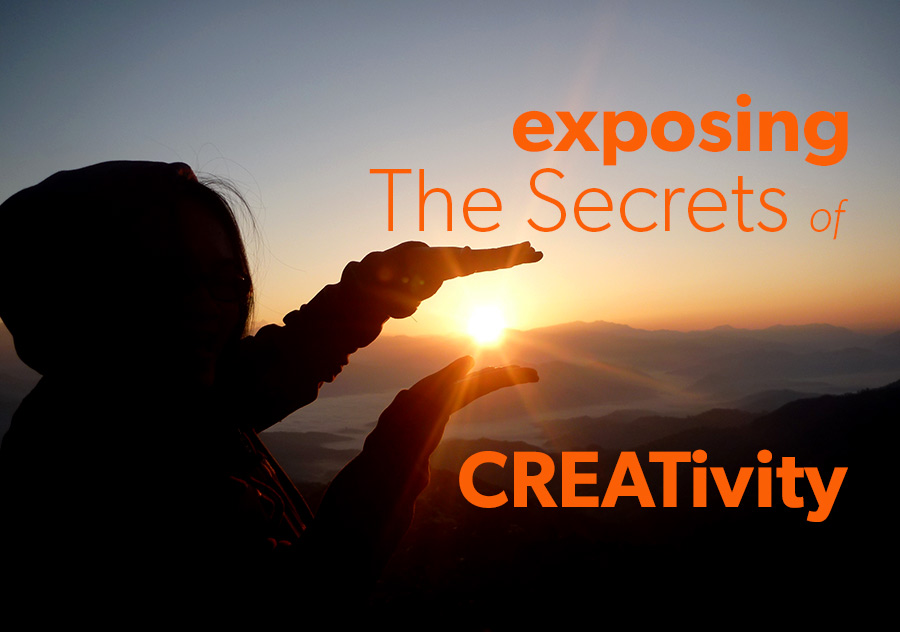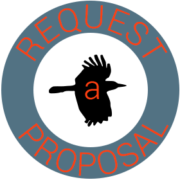The Secrets of Process & Creativity In Work & Content Writing
BINDING THREADS THAT RUN THROUGH SIMPLE WORK, PROCESS, CREATIVITY AND WRITING
Creativity and the creative process are recognized as sterling motivators and known to be critical factors in much if not all of the work we do. Yet even though there are theories and explanations of how they are understood to function, they’re still rendered somewhat invisible, lurking quietly waiting to be uncovered, illusive and undefined in many cases. Their life and breadth is both conscious and unconscious and that may make them difficult to track, define and to power up. Especially to those not trained in creative disciplines. But uncomplicated, basic processes can also lead us to creative thinking no matter what our training has been.
Here’s what got me thinking about this- I asked myself recently what it is that I love most about the simple activity of work and combined with that the work of creating content, one of the more tangibly creative activities that engages me in my job. Also my work with clients on tapping into their creative thinking for their website content has me thinking on this.
The answer to my personal question came with a realization that it’s basic process and not only overtly creative process that teases me forward with a craving to do more, to work harder and more effectively. It quite literally makes me want to work to know, in advance, that I will become engrossed in process once I begin. Its beguiling, preoccupying charm is like a carrot tempting a hungry rabbit.
proc·ess 1
ˈpräˌses,ˈprōˌses/
noun
- 1. a series of actions or steps taken in order to achieve a particular end.
verb
- 1. perform a series of mechanical or chemical operations on (something) in order to change or preserve it.
Creative Process, Work And The Work Of Content Production
I’m constructing a bridge here. I’m connecting process and creative process for work in the big sense of what “work” is (even mundane drudgery) and content creation as a sub-topic of that bigger picture. There’s no need to restrict these thoughts to one corner of our work or creative lives.
As business owners, website owners, content creators, creative people or really any kind of workers at all we are engaged in process in countless, creatively unidentified ways all the time. Why not think more broadly? Creative stimulation or discovery can be found and applied even in the most humdrum of tasks. Click To Tweet
Chop wood, carry water, right? There is not only value but also possibility in all of it, every gesture and every moment, each task.
What Do I Love? Why Do I love it?
The pleasure of being immersed in process compels me to work, to do the mundane things and the fancier shiny things. Being in-process is where I most like to be. Approaching work with creativity in tow offers me a chance to let my mind manufacture its own world and to wander freely into that world. To enter and get lost in the forest and grant myself time to examine and experience the details of the trees and whatever else I run into there. To become intimate with what I encounter and to perhaps find trails leading to nooks and crannies I have yet to discover.
It’s that thing of deliciously forgetting about time and how much of it is going by (even if just for a minute), to temporarily put aside thoughts of reaching the end-product in favor of enjoying the act of getting there. Total immersion. Even with an awareness of the need to produce and deliver, those moments in which I let go of worrying about reaching the finish line are the times in which I am most acutely engaged. And therefore, most productive.
This is some of what drove me to work hard as a visual artist. Paintings were the end-product for me as the artist. Now it’s different, but here’s something I learned-
Once a painting is finished, I find I am not as captivated by it as I was in the making. I just don’t care as much as I did while I was making it. I’m no longer living within the casing of that world I manufactured. The potential has been realized, the problems solved, completion is truly completion.
It’s not that the object I make becomes meaningless or gets cast aside but it is no longer occupying my attention in the deeply felt sense of what making it demanded of me. Once the investment of energy and focus has been spent, it is no longer necessary. It no longer serves any function. That’s because it was the process that was captivating, motivating, rewarding. Fun.
Process Is An Art In Itself
Art is not relegated solely to objects or acts of performance in the creative realm. Click To Tweet If creative process can already exist in or bleed into basic workaday tasks that we don’t ordinarily consider to be creative then we’re tapping in to our highest potential and getting more (creative) practice under our belts. That holds a promise for making our way towards enjoying ourselves more as we work and doing better work as a result.
And, well, what could be the downside of that? And if we train ourselves that way, just imagine how exhilarating it can be when we are engaging in a project that is understood to be creative.
What Happens In The Creative Process?
- There’s a sense of alert and a sense of quiet simultaneously.
- It’s an occasion to give credence to what appears in peripheral vision.
- The mind wanders aimlessly and that’s good.
- There’s an open exchange of one thing for another.
- We make unexpected, unplanned, new connections between things.
- It’s a chance to tune in while tuning out.
- The mind and our senses turn on while other demands turn off.
- Fear gives way to curiosity.
- Mistakes become opportunities.
- Exploration becomes habit.
- Being tired breaks down resistance and assists in making unusual, unexpected associations.
- Tangents and distractions help to deliver fresh ideas.
- Surprises are rewarding.
- Boredom doesn’t hurt.
- Anything is possible.
Work: An Art
“Painting and advanced writing are now closer in spirit than at any other time in living memory.”
– Artist, David Salle in his new book “How to See: Looking, Talking and Thinking About Art”, October 2016
Making connections cross-medium reveals understanding of the commonality of process in all activities. We see how our creative minds will tap into similar patterns no matter what we are doing.
When we give credence like that, raise our work to a higher standard, respect the details of it, make it precious but not stagnant, we grow inspiration for ourselves.
Just let that sink in for a moment.
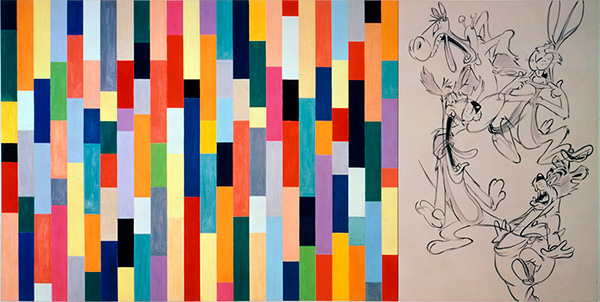
The Happy Writers, David Salle, 1981, Acrylic on canvas. 72 x 110 inches
The Mystery of Creativity
Creativity will remain somewhat mysterious and for people who are timid about it, that could mean that they may miss out.
Luckily, we can share our process when we’re done and teach by example but perhaps not from setting up a series of steps that make a set of instructions. We can describe our thinking, our experience, how we got from Point A to Point B or Z.
But What About Meaning?
Thing is, we can try to inject meaning and we’ll find that no matter how closely we think we are pinning something down, there will be varied resonance coming from the people we expose our work to; varied response, varied understanding and varied future usage of what we make.
That gives life to the work we do beyond our own hands and minds. It gives our work an opportunity to live past whatever we are able to conceive or bestow upon it. Makes it smarter in the end because each viewer, each reader, each person that encounters it will add value, interest to its existence. And then pass it on to the next viewer, reader, experiencer.
There is creativity even in experiencing something someone else made. Click To TweetThese are ideas that foster creative action and a willingness to wander into unknown territory in order to be in process and to produce.
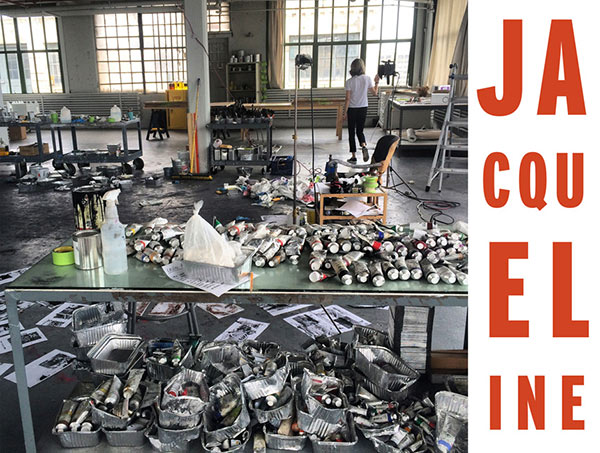
Jacqueline Humphries November 19, 2015 | by FiftyTwo45
Excerpt from a conversation between two painters, Cecily Brown and Jacqueline Humphries:
JH: “I don’t think the artist can determine the meaning of content. What I am trying to do is alter baseline conditions of viewing to anticipate a new kind of viewing, to establish a site for “content” or experience. In a way, the paintings resist meaning.”
CB: “I wouldn’t want to pin it down that much, either…”
JH: “… It’s not so much that I’m driving at uncertainty as content as much as I want to captivate and entertain a viewer. I think a painter’s first job is to get someone to look at a painting…”
CB: “In a way, that’s what painting has always done. A painting shifts and changes as one moves backward and forward; it has from Velásquez to Pollock. If destabilization isn’t your content, it’s at least something that’s always present.”
Surprisingly, One Of The Best Things About Creative Process Is That It’s Personally Defined & Executed
As Gideon Rosenblatt recently said, to write from the heart is to give a gift to those we are writing for. The sentiment dovetails perfectly here in any form of work.
Allowing our truly authentic selves to rise to the occasion and to become fully taken up by process will usually mean that we’ve given a space for what’s in our heart, the name we’ve given to the part of us we refer to in order to describe our true, inner selves. Opening the direct line to who we really are. That’s where the magic emerges. Creativity in its pure essence. We are embodying fidelity to our experience.
Subjectivity and individuality make sense. We are each different. We each have a unique way to uncover what we’re looking for or not looking for. Our intimate, self-derived methods, necessarily, cannot be duplicated. We’re left to ourselves to sort our own and that’s a good thing. That may also be the worst for some because it means that there are no easy instructions, no simple answers. And obviously, no formulas.
The Driving Force Found In The Middle & Flow
Getting To The Middle of Process
I find there is nothing as stimulating as being in the middle – being involved with what is already here. Being at the stage of just doing, getting to engage with whatever is already there. I’ve watched myself struggle in the internal battles to get myself started so I can reach that delicious place that can usually only be found in the middle, fighting to find my way into that manufactured world. It’s sometimes painful but always worth it.
The danger lies only in then having resistance to finishing because it means I will have to start again and sometimes I’d like to avoid that at almost all costs. Yet if it’s business we’re talking about, finish, we must. On the other hand, there are things we can learn from art making and artists about what not always rushing to finish might offer.

Image courtesy of http://www.metmuseum.org/exhibitions/listings/2016/unfinished
“This exhibition addresses a subject critical to artistic practice: the question of when a work of art is finished.”
“Robert Rauschenberg, who alternately blurred the distinction between making and un-making, extended the boundaries of art into both space and time, and recruited viewers to complete the objects they had begun.”
“Beginning with the Renaissance masters, this scholarly and innovative exhibition examines the term “unfinished” in its broadest possible sense, including works left incomplete by their makers, which often give insight into the process of their creation, but also those that partake of a non finito—intentionally unfinished—aesthetic that embraces the unresolved and open-ended. Some of history’s greatest artists explored such an aesthetic, among them Titian, Rembrandt, Turner, and Cézanne. The unfinished has been taken in entirely new directions by modern and contemporary artists, among them Janine Antoni, Lygia Clark, Jackson Pollock, and Robert Rauschenberg, who alternately blurred the distinction between making and un-making, extended the boundaries of art into both space and time, and recruited viewers to complete the objects they had begun.”
–Exhibition overview, Metropolitan Museum’s “Unfinished, Thoughts Left Visible”
I highly recommend watching this very short video from the exhibition.
Get In The Flow State
What I am ultimately describing when I talk about the “middle” is Flow or being “in the zone” as it’s also commonly described.
“In positive psychology, flow, also known as the zone, is the mental state of operation in which a person performing an activity is fully immersed in a feeling of energized focus, full involvement, and enjoyment in the process of the activity. In essence, flow is characterized by complete absorption in what one does.”
It was named by Mihály Csíkszentmihályi in 1975 but it was not a new concept. It had existed for thousands of years particularly in the eastern religions Buddhism, Taoism, Hinduism. They each refer to similar states.
Csíkszentmihályi became interested in studying flow because of what he observed in artists and how they have the ability to become extremely immersed in their work to the abandonment of even the most fundamental human needs like sleep and food. Flow is seen in applications of education, music- especially in improvisation, sports and martial arts, gaming, in the work place under the right conditions.
The key points of flow experience identified by he and Jeanne Nakamura are:
- Intense and focused concentration on the present moment
- Merging of action and awareness
- A loss of reflective self-consciousness
- A sense of personal control or agency over the situation or activity
- A distortion of temporal experience, one’s subjective experience of time is altered
- Experience of the activity as intrinsically rewarding, also referred to as autotelic experience
Sound familiar? Yes, the flow state has an intimate relationship with creativity. In fact, the flow state fosters and naturally trains us for creativity. Our brains will do the work without us trying.
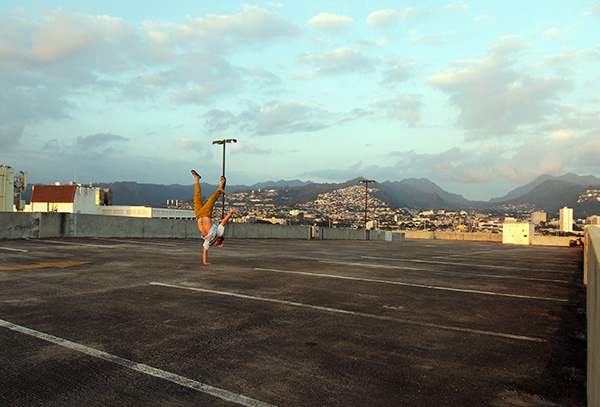
Courtesy Eric Broder Van Dyke
In the flow state our brainwaves slow down. Instead of being run by the fast pace of the beta of normal waking consciousness we enter to a rhythm that’s at a pace between alpha and theta. Alpha is associated with day-dreaming, a place that doesn’t inflict much resistance to thoughts. We drift freely. Make unexpected lateral connections more freely. Theta exists in both REM sleep and just before we fall asleep with those crazy nonsensical flipbooks of unrelated thoughts and images. I think we’ve all been there.
What instigates flow is the deactivation of our higher cognitive function in the dorsolateral prefrontal cortex. This is why our sense of self (and self-consciousness) quiets down. The other areas that take a back seat are the parts of the brain that are in charge of self-monitoring, impulse control, our inner critic, the voice of doubt. So what happens is we’re more willing to play, to take risks, we have more courage and a greater capacity for imagining the potential of a thing.
All this and among other mechanisms large quantities of feel good, performance enhancing chemicals norepinephrine, dopamine, endorphins and serotonin are released during flow impacting our creativity positively.
What Can You Do If You Think You Are Not Creative?
I don’t believe there’s any such thing. The so-called gift of creativity may be on a continuum, but it is not a gift that is either given or denied at birth. Everyone is entitled to it. Getting into the zone and knowing we’re there is a skill that requires muscles and keeping them in shape much like any other skill whether it be in the sciences or making art, music or in athletic endeavors. We each have potential built-in and we each have access. Trust in one’s own ability to let ideas erupt and evolve is something I believe we are all entitled to. Each and every one of us.
Do you regard yourself as being barred from the pleasures of creativity? Grin and bear it, dive in and get bold. Fake it till you make it. Mess around. Don’t take yourself too seriously. Seriously.
As a web development firm, we are continually in the position of advising clients about content creation. People we work with are often unsure of which steps to take when challenged with producing content.
I try to be encouraging. When we feel most challenged is the time to go granular and pay closer attention to process. Click To Tweet
Let it be important and helpful. I’m referring to literal process- the thoughts in our head and how we follow or abandon the trains of them. It’s individual and perhaps hard to track. Create your own systems but give them fluidity. There is no right and there is no wrong.
There does not need to be a repeatable pattern for creative action to take place.
When It Comes to Content Creation, There’s Always Advice To Be Found
There’s no shortage of articles, descriptive analyses of content production processes. We read over and over (and over) again ways to arrive at fresh ideas, tricks, how to streamline, how to manage if you’re a small business without the resources to be a content machine. It’s a serious challenge to find time in our times.
We learn we must not only create but to create remarkable content, anchor content, 10X content. I’m not complaining. There is nothing inherently wrong with any of that and much of it is helpful. And inasmuch as it’s true, it’s important instruction offered to us by people who have tested its validity.
In so many ways, those articles don’t really go far enough, though. Or perhaps it’s that they go too far, skipping over something important. They don’t quite get to some of the more fundamental issues when we face off with a blank screen or an empty bunch of video frames to make content that will matter.
“The question of what creativity is and how it works will perhaps remain humanity’s most unanswerable — but that hasn’t stopped us from trying.”
– The Ten Stages Of Creativity from Maria Popova, Brainpickings.org
The Creative Pause & More
I like the idea of a pause. Taking a breath, turning our gaze, asking a question. Click To TweetLegendary creative thinker, Edward de Bono, created the term “The creative pause” to describe how stopping to think differently can lead us to arriving at some of the best results. Martin Lindstrom in his article, “Want To Be More Creative? Get Bored” describes welcoming boredom and how he makes the pause for himself to incite a deeper experience of creativity.
If you’re looking to put a jolt into your creative powers you might try these: Being tired, exercising, surrounding yourself with ambient noise levels, traveling abroad, dim lighting, blue and green, constraints, a separate and messy desk, being sleepy. Ten Surprising Ways to Transform Your Creative Thinking, Belle Beth Cooper, Fast Company. In other words, breaking down your resistance. Challenging your comfort.

Imagine the possibilities. Or simply dive in and see what happens.
The Stages Of Creativity
Also from Brainpickings and brilliantly described, “The Art of Thought: A Pioneering 1926 Model of the Four Stages of Creativity, How to master the beautiful osmosis of conscious and unconscious, voluntary and involuntary, deliberate and serendipitous.” Graham Wallas, at the age of sixty-eight wrote The Art of Thought, four overlapping stages of creativity.
- Preparation
- Incubation
- Illumination
- Verification
Caution Against Rules
These stages are without sequence and continual, leapfrogging their way to the forefront and then sitting side by side and taking turns only to start over again in a new order. That’s how it is with creativity- haphazard, undefinable, a curiosity, about listening and seeing, thinking and not thinking. Spontaneity, taking risks, not caring about how things will turn out. We need to learn to not care how things will turn out in order to eventually have them turn out in ways we are fond of, that work for us and our goals.
We do that in order to have things turn out effectively, with intelligence and usefulness. It’s how to create things that will matter.
What To Do
Start small. Literally. Begin with one thought, or fragment of a thought, one small idea, one word, and then one phrase, sentence, paragraph and pursue it in a modest way.
Swap up your medium. If you are writing, draw one line with a pencil instead. If you are drawing, type a word. Rip your paper in half and put it back together wrong. If you are taking a photograph, look up close and then far away. Change your angle, your perspective. Crop.
Do not pressure yourself. Simply open a door and step in through the threshold one moment at a time. I think you’ll find that one thing leads to another. And another.
Do not put pressure on yourself about producing. Give yourself the chance to do without purpose. Foster play.
Do your research. There are endless numbers of articles about creative process. See if theories give you a handhold, but I advise against adopting them too strongly. That can be limiting when really what you’re seeking is to open the field of discovery, not overly define it. Give yourself permission to break rules, challenge expectations and give yourself the privacy you might need to make a lot of messes.
“As performing artists and as dancers, we see everything as art.”
Lil Buck at Foundation Louis Vuitton
SUBSCRIBE & RECEIVE BLOG NOTIFICATIONS OF NEW POSTS:
* Don’t miss any of our blog posts! Subscribe below.
GOOGLE PLUS POST NOTIFICATIONS:
* Please follow the Fat Eyes Blog Collection, Digital Marking Insights on Google Plus.
Photo Credits:
Pre-remix Header photo, iStock, Copyright: oh_warinee
David Salle painting
Metropolitan Museum Catalog cover
Jacqueline Humphries: bombmagazine.org
One armed handstand copyright Eric Broder Van Dyke
Eye: Copyright: Igor Sinkov

